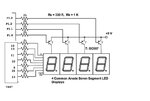sruthi009
Newbie level 5
Hi,
I wants to get the output of seven segment(0 to 999) multiplexing,thats why i searched in google i got the program for seven segment multiplexing,but in that coding four seven segments are connected to microcontroller directly,but in my board, thery connected seven segment through buffer to miccorcontroller.Now which one i have to change coding part to get the out,i pasted the code below.
I wants to get the output of seven segment(0 to 999) multiplexing,thats why i searched in google i got the program for seven segment multiplexing,but in that coding four seven segments are connected to microcontroller directly,but in my board, thery connected seven segment through buffer to miccorcontroller.Now which one i have to change coding part to get the out,i pasted the code below.
Code C - [expand]
Last edited by a moderator:


